|
Family: Phasianidae (partridges, francolins, spurfowls and quail)
Life
> Eukaryotes >
Opisthokonta
> Metazoa (animals) >
Bilateria >
Deuterostomia > Chordata >
Craniata > Vertebrata (vertebrates) > Gnathostomata (jawed
vertebrates) > Teleostomi (teleost fish) > Osteichthyes (bony fish) > Class:
Sarcopterygii (lobe-finned
fish) > Stegocephalia (terrestrial
vertebrates) > Tetrapoda
(four-legged vertebrates) > Reptiliomorpha > Amniota >
Reptilia (reptiles) >
Romeriida > Diapsida > Archosauromorpha > Archosauria >
Dinosauria
(dinosaurs) > Saurischia > Theropoda (bipedal predatory dinosaurs) >
Coelurosauria > Maniraptora > Aves
(birds) > Order: Galliformes
Species native or naturalised (*) in southern Africa
|
* Alectoris
chukar (Chukar partridge)
This species has become naturalised on Robben Island (off Cape Town).
It is native to southern Europe through to central Asia
and China.
|
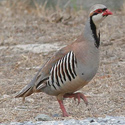 |
|
Coturnix
adansonii (Blue quail) A summer
breeding migrant to southern Africa occurring in Zimbabwe and Mozambique
with isolated records also from eastern regions of South Africa. Most often
occurs in moist grassy habitats within woodland, often along the border of
wetlands.The male is a colourful, attractively patterned quail with
black and white throat and unlike other local quails, does not have a white
eyebrow stripe. It also has distinctive slate blue colouring on the breast. In flight
the rufous on the upper wing coverts is distinctive. The female and juvenile can
be distinguished from other quails by the barring on breast and flanks. |
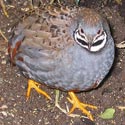 |
|
Coturnix
coturnix (Common quail) The commonist
quail in southern Africa occurring in grassy habitats, including cultivated
fields. The male can be distinguished from other quails by its black- to
russet-coloured throat. Female has paler underparts than female Harlequin
quail and lacks the barred patterning on the underparts found in female Blue
quail. |
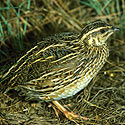 |
|
Coturnix
delegorguei (Harlequin quail) Found in
grasslands, open savannas and fields; generally absent from arid and
temperate regions of southern Africa. Male at rest is easily distinguished from the
Blue and
Common quails by the chestnut and black underparts. It also differs from the
similarly dark-coloured male Blue quail in having a white eyebrow stripe.
Female looks similar to the female Common quail but has darker
chestnut-coloured underparts without a whitish coloured belly. It differs
from the female Blue quail in not having barred patterning on the
underparts. |
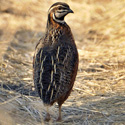 |
|
Pternistis
adspersus (Red-billed spurfowl, Red-billed francolin) Occurs in dry savannas of northern Namibia, SW Angola,
Botswana, W Zimbabwe and W North West Province. The only francolin in southern Africa with yellow around
the eye. This, as well as the combination of red bill, red legs, absence of
white or red on the throat make identification of this species easy.
|
 |
|
Pternistis
afer (Red-necked spurfowl, Red-necked francolin)
Has a wide distribution, occurring from near Swellendam in the
Western Cape, through the Eastern Cape, inland regions of KwaZulu-Natal,
Mpumalanga, S Limpopo, Mozambique, E Zimbabwe, and beyond southern Africa as far
north as East Africa. Found where there is dense cover such as along forest
and river edges. The only spurfowl in southern Africa with red bill, red
around the eyes, red throat and red legs. The black streaking on the flanks
against a silvery/grey/white background is also distinctive.
|
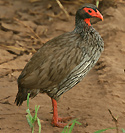 |
|
Pternistis
swainsonii (Swainson's spurfowl, Swainson's francolin)
Occurs in grasslands or open savannas and adapts easily to
cultivated, disturbed areas. Distinguished from other spurfowl by the
combination of red face, red throat, black upper bill and black legs. |
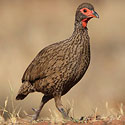 |
|
Pternistis
capensis (Cape spurfowl, Cape francolin)
An endemic species concentrated mainly in the Western Cape but extends into
Northern Cape, southern Namibia and Eastern Cape. Found mainly in fynbos and
karoo but also in gardens and agricultural settings. The only
similar-looking spurfowl without red or yellow face or red throat is the
Natal spurfowl but their ranges do not overlap and Cape spurfowl can also be
distinguished by having streaked, not scaly, underparts.
|
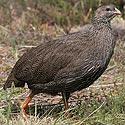
|
|
Pternistis
natalensis (Natal spurfowl, Natal francolin)
Occurs in E South Africa, E Botswana,
Zimbabwe, N Mozambique and outside of southern Africa it is found in S
Zambia. Found in savanna, woodland and coastal forest. Within its range it is the only spurfowl without bare skin
around the eyes and on the throat. The Cape spurfowl also lacks these features
but the ranges don't overlap and in addition it has a scaly-patterned lower
breast without the streaks found in Cape spurfowl.
|
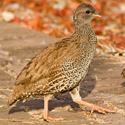 |
|
Pternistis
hartlaubi (Hartlaub's spurfowl, Hartlaub's francolin) Patchily distributed through northern Namibia and SW
Angola. Found where there are rocky outcrops, or scattered boulders. Compared to other francolins, the Hartlaub's spurfowl has a
longer, more down-curved bill. In addition, the male can be distinguished by its
white eye stripe and dark cap and the female by the uniform reddish-brown
underparts.
|
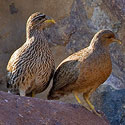 |
|
Dendroperdix
sephaena (Crested
francolin)
Found in woodland and wooded savanna in a distribution
extending from Ethiopia down to the northern regions of southern Africa. Can be distinguished from other francolins by the broad
white eye-stripe contrasting with the dark head, combined with the white throat. Its habit of cocking its tail
(see image right) is also a useful distinguishing feature.
|
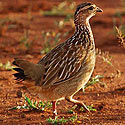 |
|
Peliperdix
coqui (Coqui francolin)
Widespread in savanna and woodland regions of Africa. The male is easily distinguished from other francolins by
the plane reddish-brown head contrasting with the barred underparts. The female
can be distinguished from other francolins (Shelley's francolin in particular)
by the white eye stripe and lack of chestnut stripes on breast and flanks.
|
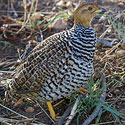 |
|
Scleroptila
africanus (Grey-winged francolin)
Found in montane grasslands in the Drakensberg region
(mainly above 1800 m elevation) and also occurs in karoo scrub, renosterbos
and strandveld in the Western and Eastern Cape provinces.Can be
distinguished from other Scleroptila francolins by having a grey
freckled rather than white or buff throat. In flight, there is
proportionally more grey than red on the wings compared to the other
species.
|
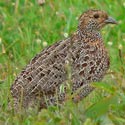 |
|
Scleroptila
levaillantii (Red-winged francolin)
There are about seven separate populations distributed
through Africa with the population in southern Africa ranging from Swellendam in the Western Cape, up the east coast, round Lesotho
and into the highveld. In the Western Cape it is found in high altitude
mountain fynbos and elsewhere it is found mainly in grasslands dominated by the
grass Themeda triandra. |
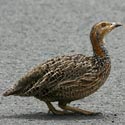 |
|
Scleroptila
levaillantoides (Orange River francolin)
Found in grasslands and arid savannas. Near endemic to
southern Africa with a distribution extending from southern Angola, through
northern Namibia and Botswana and into the Free State and adjacent regions.
Highly variable in plumage pattern and most easily confused with the
Red-winged francolin from which it can be distinguished by having a thin,
not broad, breast band. |
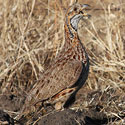 |
|
Scleroptila
shelleyi (Shelley's francolin)
Distributed through NE regions of southern Africa, extending north into East
Africa. Found in savanna and woodland, particularly where there is rocky
ground. Distinguished by the black-and-white patterning on the lower breast
and belly, which contrasts with the chestnut and buff patterned upper
breast. |
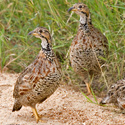 |
|
* Pavo
cristatus (Common peacock)
Indigenous to Pakistan, India and Sri Lanka. Introduced to
South Africa in 1968 and there are now naturalised populations on Robben Island, Cape
Peninsula, Port Elizabeth and East London. |
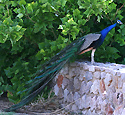 |
References
-
Hockey PAR, Dean WRJ and Ryan PG (eds) 2005. Roberts
- Birds of southern Africa, VIIth ed. The Trustees of the John Voelcker
Bird Book Fund, Cape Town.
-
Sinclair, I, Hockey, P. and Tarboton, W. 2002. Sasol
Birds of Southern Africa. 3rd edition. Struik, Cape Town.
Text by Hamish Robertson |
